(iii) State how your answer in (ii) would differ if the sale were to be delayed until August 2006. (3 marks)
题目
(iii) State how your answer in (ii) would differ if the sale were to be delayed until August 2006. (3 marks)
相似考题
更多“(iii) State how your answer in (ii) would differ if the sale were to be delayed until August 2006. (3 marks)”相关问题
-
第1题:
(c) In August 2004 it was discovered that the inventory at 31 December 2003 had been overstated by $100,000.
(4 marks)
Required:
Advise the directors on the correct treatment of these matters, stating the relevant accounting standard which
justifies your answer in each case.
NOTE: The mark allocation is shown against each of the three matters.
正确答案:
(c) The opening inventory should be included in the current year’s income statement at the corrected figure, and the opening
balance of retained profit reduced by $100,000. The $100,000 reduction will appear in the statement of changes in equity.
(IAS8 Accounting policies, changes in accounting estimates and errors) -
第2题:
(ii) Construct the argument against Professor West’s opinion, and in favour of Professor Leroi’s opinion that
a principles-based approach would be preferable in developing countries. Your answer should consider
the particular situations of developing countries. (10 marks)
正确答案:
(ii) Principles-based approach
Advantages of a principles-based approach
The rigour with which governance systems are applied can be varied according to size, situation, stage of development
of business, etc. Organisations (in legal terms) have a choice to the extent to which they wish to comply, although they
will usually have to ‘comply or explain’. Explanations are more accepted by shareholders and stock markets for smaller
companies.
Obeying the spirit of the law is better than ‘box ticking’ (‘sort of business you are’ rather than ‘obeying rules’). Being
aware of overall responsibilities is more important than going through a compliance exercise merely to demonstrate
conformance.
Avoids the ‘regulation overload’ of rules based (and associated increased business costs). The costs of compliance have
been a cause of considerable concern in the United States.
Self-regulation (e.g. by Financial Services Authority in the UK) rather than legal control has proven itself to underpin
investor confidence in several jurisdictions and the mechanisms are self-tightening (quicker and cheaper than legislation)
if initial public offering (IPO) volumes fall or capital flows elsewhere.
Context of developing countries
Developing countries’ economies tend to be dominated by small and medium sized organisations (SMEs). It would be
very costly and probably futile, to attempt to burden small businesses with regulatory requirements comparable to larger
concerns.
Having the flexibility to ‘comply or explain’ allows for those seeking foreign equity to increase compliance whilst those
with different priorities can delay full compliance. In low-liquidity stock markets (such as those in some developing
countries) where share prices are not seen as strategically important for businesses, adopting a more flexible approach
might be a better use of management talent rather than ‘jumping through hoops’ to comply with legally-binding
constraints.
The state needs to have an enforcement mechanism in place to deal with non-compliance and this itself represents a
cost to taxpayers and the corporate sector. Developing countries may not have the full infrastructure in place to enable
compliance (auditors, pool of NEDs, professional accountants, internal auditors, etc) and a principles-based approach
goes some way to recognise this. -
第3题:
(b) Comment (with relevant calculations) on the performance of the business of Quicklink Ltd and Celer
Transport during the year ended 31 May 2005 and, insofar as the information permits, its projected
performance for the year ending 31 May 2006. Your answer should specifically consider:
(i) Revenue generation per vehicle
(ii) Vehicle utilisation and delivery mix
(iii) Service quality. (14 marks)
正确答案: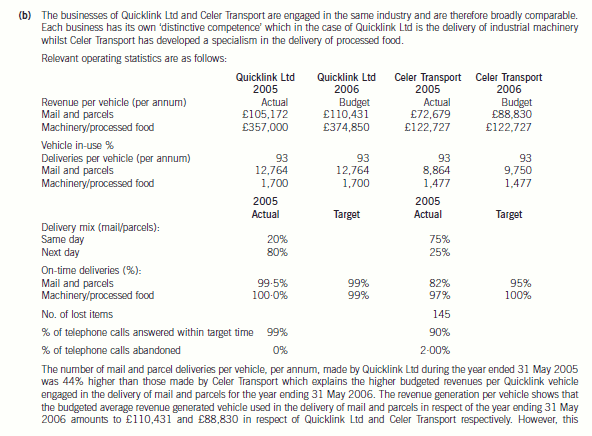
difference will reduce in the year ending 31 May 2006 due to the projected growth in sales volumes of the Celer Transport
business. The average mail/parcels delivery of mail/parcels per vehicle of the Quicklink Ltd part of the business is budgeted
at 12,764 which is still 30·91% higher than that of the Celer Transport business.
As far as specialist activities are concerned, Quicklink Ltd is budgeted to generate average revenues per vehicle amounting to
£374,850 whilst Celer Transport is budgeted to earn an average of £122,727 from each of the vehicles engaged in delivery
of processed food. It is noticeable that all contracts with major food producers were renewed on 1 June 2005 and it would
appear that there were no increases in the annual value of the contracts with major food producers. This might have been
the result of a strategic decision by the management of the combined entity in order to secure the future of this part of the
business which had been built up previously by the management of Celer Transport.
Each vehicle owned by Quicklink Ltd and Celer Transport is in use for 340 days during each year, which based on a
365 day year would give an in use % of 93%. This appears acceptable given the need for routine maintenance and repairs
due to wear and tear.
During the year ended 31 May 2005 the number of on-time deliveries of mail and parcel and industrial machinery deliveries
were 99·5% and 100% respectively. This compares with ratios of 82% and 97% in respect of mail and parcel and processed
food deliveries made by Celer Transport. In this critical area it is worth noting that Quicklink Ltd achieved their higher on-time
delivery target of 99% in respect of each activity whereas Celer Transport were unable to do so. Moreover, it is worth noting
that Celer Transport missed their target time for delivery of food products on 975 occasions throughout the year 31 May 2005
and this might well cause a high level of customer dissatisfaction and even result in lost business.
It is interesting to note that whilst the businesses operate in the same industry they have a rather different delivery mix in
terms of same day/next day demands by clients. Same day deliveries only comprise 20% of the business of Quicklink Ltd
whereas they comprise 75% of the business of Celer Transport. This may explain why the delivery performance of Celer
Transport with regard to mail and parcel deliveries was not as good as that of Quicklink Ltd.
The fact that 120 items of mail and 25 parcels were lost by the Celer Transport business is most disturbing and could prove
damaging as the safe delivery of such items is the very substance of the business and would almost certainly have resulted
in a loss of customer goodwill. This is an issue which must be addressed as a matter of urgency.
The introduction of the call management system by Quicklink Ltd on 1 June 2004 is now proving its worth with 99% of calls
answered within the target time of 20 seconds. This compares favourably with the Celer Transport business in which only
90% of a much smaller volume of calls were answered within a longer target time of 30 seconds. Future performance in this
area will improve if the call management system is applied to the Celer Transport business. In particular, it is likely that the
number of abandoned calls will be reduced and enhance the ‘image’ of the Celer Transport business.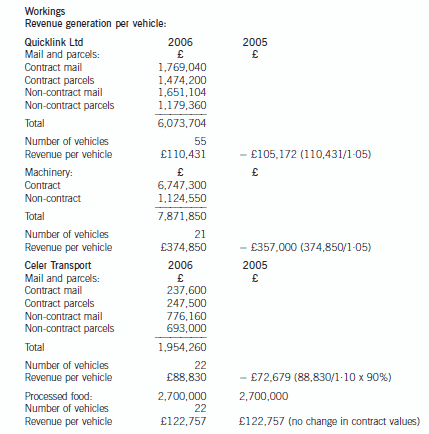

-
第4题:
(ii) Recommend which of the refrigeration systems should be purchased. You should state your reasons
which must be supported by relevant calculations. (3 marks)
正确答案:
-
第5题:
(c) State the tax consequences for both Glaikit Limited and Alasdair if he borrows money from the company, as
proposed, on 1 January 2006. (3 marks)
正确答案:
(c) Alasdair is not employed, nor is he a director, of Glaikit Limited. As he holds 25% of the shares in Glaikit Limited, he is a
participator in a close company and therefore the special close company provisions will apply. Thus Alsadair will be taxed
under the ‘loans to participator’ rules.
When the loan is written off, the amount waived will be treated as a gross distribution of £16,667 (£15,000 x 10/9). This
will be assessed in the tax year in which the loan is written off (expected to be 2006/07 or 2007/08). To the extent that this
additional income makes Alasdair a higher rate taxpayer in that year, he will have to pay additional income tax of 32·5% of
the gross amount, less the available 10% tax credit.
From the company’s perspective, Glaikit Limited will have to pay 25% of the net value of any loan made to Alasdair which
has not been repaid to the company (or written off) within nine months of the year end. As the loan will remain outstanding
as at 31 March 2006, Glaikit Limited will have to pay £3,750 (25% x £15,000) to the Revenue by 1 January 2007. This
amount will not be repaid until the loan is repaid or written off. This usually takes place nine months after the year end in
which the loan is written off, so Glaikit Limited should ensure that any write-off occurs prior to 31 March 2007, or else the
repayment may be delayed for up to one year.
As the loan is tax free, the Revenue may also seek to tax Alasdair under the beneficial loan rules. If the Revenue were to seek
an assessment in this manner, the value of the benefit would be calculated and taxed as a deemed distribution. However, as
Alasdair has no connection with the company other than as an investor, it is unlikely that the beneficial loan benefit will lead
to such a deemed distribution. -
第6题:
(ii) Explain the income tax (IT), national insurance (NIC) and capital gains tax (CGT) implications arising on
the grant to and exercise by an employee of an option to buy shares in an unapproved share option
scheme and on the subsequent sale of these shares. State clearly how these would apply in Henry’s
case. (8 marks)
正确答案:
(ii) Exercising of share options
The share option is not part of an approved scheme, and will not therefore enjoy the benefits of such a scheme. There
are three events with tax consequences – grant, exercise and sale.
Grant. If shares or options over shares are sold or granted at less than market value, an income tax charge can arise on
the difference between the price paid and the market value. [Weight v Salmon]. In addition, if options can be exercised
more than 10 years after the date of the grant, an employment income charge can arise. This is based on the market
value at the date of grant less the grant and exercise priced.
In Henry’s case, the options were issued with an exercise price equal to the then market value, and cannot be exercised
more than 10 years from the grant. No income tax charge therefore arises on grant.
Exercise. On exercise, the individual pays the agreed amount in return for a number of shares in the company. The price
paid is compared with the open market value at that time, and if less, the difference is charged to income tax. National
insurance also applies, and the company has to pay Class 1 NIC. If the company and shareholder agree, the national
insurance can be passed onto the individual, and the liability becomes a deductible expense in calculating the income
tax charge.
In Henry’s case on exercise, the difference between market value (£14) and the price paid (£1) per share will be taxed
as income. Therefore, £130,000 (10,000 x (£14 – £1)) will be taxed as income. In addition, national insurance will
be chargeable on the company at 12·8% (£16,640) and on Henry at the rate of 1% (£1,300).
Sale. The base cost of the shares is taken to be the market value at the time of exercise. On the sale of the shares, any
gain or loss arising falls under the capital gains tax rules, and CGT will be payable on any gain. Business asset taper
relief will be available as the company is an unquoted trading company, but the relief will only run from the time that
the share options are exercised – i.e. from the time when the shares were acquired.
In Henry’s case, the sale of the shares will immediately follow the exercise of the option (6 days later). The sale proceeds
and the market value at the time of exercise are likely to be similar; thus little to no gain is likely to arise. -
第7题:
(ii) Following on from your answer to (i), evaluate the two purchase proposals, and advise Bill and Ben
which course of action will result in the highest amount of after tax cash being received by the
shareholders if the disposal takes place on 31 March 2006. (4 marks)
正确答案: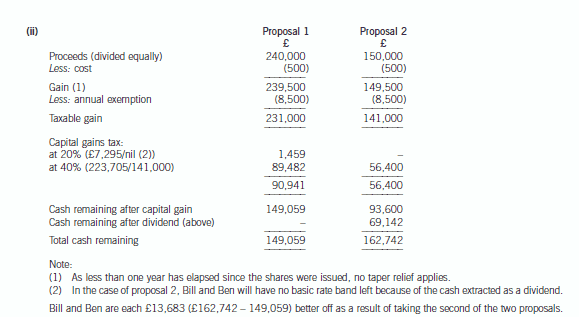
-
第8题:
(ii) Analyse the effect of delaying the sale of the business of the Stiletto Partnership to Razor Ltd until
30 April 2007 on Clint’s income tax and national insurance position.
You are not required to prepare detailed calculations of his income tax or national insurance liabilities.
(4 marks)
正确答案:(ii) The implications of delaying the sale of the business
The implications of delaying the sale of the business until 30 April would have been as follows:
– Clint would have received an additional two months of profits amounting to £6,920 (£20,760 x 1/3).
– Clint’s trading income in 2006/07 would have been reduced by £13,015 (£43,723 – £30,708), much of which
would have been subject to income tax at 40%. His additional trading income in 2007/08 of £19,935 would all
have been taxed at 10% and 22%.
– Clint is entitled to the personal age allowance of £7,280 in both years. However, it is abated by £1 for every £2
by which his total income exceeds £20,100. Once Clint’s total income exceeds £24,590 (£20,100 + ((£7,280
– £5,035) x 2)), his personal allowance will be reduced to the standard amount of £5,035. Accordingly, the
increased personal allowance would not be available in 2006/07 regardless of the year in which the business was
sold. It is available in 2007/08 (although part of it is wasted) but would not have been if the sale of the business
had been delayed.
– Clint’s class 4 national insurance contributions in 2006/07 would have been reduced due to the fall in the level
of his trading income. However, much of the saving would be at 1% only. Clint is not liable to class 4 national
insurance contributions in 2007/08 as he is 65 at the start of the year.
– Changing the date on which the business was sold would have had no effect on Clint’s class 2 liability as he is
not required to make class 2 contributions once he is 65 years old.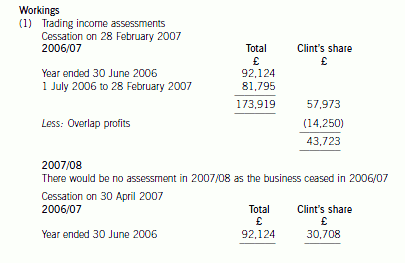
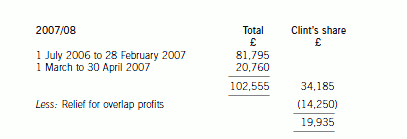
-
第9题:
(iii) Advice in connection with the sale of the manufacturing premises by Tethys Ltd; (7 marks)
正确答案:
(iii) Tethys Ltd – Sale of the manufacturing premises
Value added tax (VAT)
– The building is not a new building (i.e. it is more than three years old). Accordingly, the sale of the building is an
exempt supply and VAT should not be charged unless Tethys Ltd has opted to tax the building in the past.
Taxable profits on sale
– There will be no balancing adjustment in respect of industrial building allowances as the building is to be sold on
or after 21 March 2007.
– The capital gain arising on the sale of the building will be £97,760 (£240,000 – (£112,000 x 1·27)).
Rollover relief
– Tethys Ltd is not in a capital gains group with Saturn Ltd. Accordingly, rollover relief will only be available if Tethys
Ltd, rather than any of the other Saturn Ltd group companies, acquires sufficient qualifying business assets.
– The amount of sales proceeds not spent in the qualifying period is chargeable, i.e. £40,000 (£240,000 –
£200,000). The balance of the gain, £57,760 (£97,760 – £40,000), can be rolled over.
– Qualifying business assets include land and buildings and fixed plant and machinery. The assets must be brought
into immediate use in the company’s trade.
– The assets must be acquired in the four-year period beginning one year prior to the sale of the manufacturing
premises.
Further information required:
– Whether or not Tethys Ltd has opted to tax the building in the past for the purposes of VAT. -
第10题:
(ii) Describe the evidence you would seek to support the assertion that development costs are technically
feasible. (3 marks)
正确答案:
(ii) Evidence supporting the assertion that development costs are technically feasible would include the following:
– Review the results of scientific tests performed on the products, for example, the results of animal or human testing
of the products.
– Discuss any detrimental results of these tests, e.g. harmful side effects, with the scientists working on the project
to determine what corrective action is being taken.
– Enquire whether any licences necessary for continued development and/or commercial production have been
granted by the appropriate regulatory body.
– Compare expected to actual development costs incurred per product being developed. Where actual costs are in
excess of expected costs investigate whether the extra costs have been incurred in order to make good any problems
identified in the development process.
– Review board minutes for relevant discussion of the product development taking place during the year. -
第11题:
问答题TaskⅡ (20 marks) Write an article of no fewer than 120 words telling other students how you control stress about your courses.Take My Advice on How to Control Stress You should write the article on the answer sheet.正确答案:
Take My Advice on How to Control Stress As the competition between students increases, more and more students feel stressful about their courses. As far as I’m concerned, we can take the initiative to reduce the stress.
Firstly, make a plan for everyday study. For instance, you keep learning English for two hours every day, and within the two hours, you’ll learn 10 new words and read 2 articles. This way you can learn more than 1000 English words three months later and your reading ability will improve as well. Therefore, you don’t have to stay up late before the English examination. As long as you keep learning every day, you will find you are well prepared for the exams already.
Secondly, do something else to divert your mind before exams. For example, if you can play piano, play your favorite songs for one or two hours and you will feel relaxed.
To conclude, keep learning regularly and cultivate a hobby and you will find yourself relaxed about your courses.解析: 暂无解析 -
第12题:
问答题Test 12 Friendship is forever a topic for human beings. How do you view “friendship”? Write on ANSWER SHEET TWO a composition of about 200 words on the following topic:FRIENDSHIP You are to write in three parts. In the first part, state specifically what your idea is. In the second part, provide one or two reasons to support your idea OR describe your idea. In the last part, bring what you have written to a natural conclusion or a summary. Marks will be awarded for content, organization, grammar and appropriateness. Failure to follow the instructions may result in a loss of marks.正确答案:
【参考范文】
Friends are indispensable in our daily life. When we feel happy, we can share the pleasure with them; when we feel gloomy, friends will comfort us; when we have some secrets, we just want to share them with friends; and when we have difficulties, friends are always ready to help us.
Life is a bouquet, friendship is flower. We cannot live without friendship just as we cannot survive without air or water. Friendship gives us a feeling of security and warmth; friendship encourages us to go ahead when we encounter difficulty.
Building friendship takes time. True friendship requires equality and loyalty. It is an in-depth relationship combining trust, support, understanding, empathy and intimacy. True friendship should be able to stand all kinds of tests. Just as an old saying goes, “A friend in need is a friend indeed.”
In conclusion, we must treasure our friends and friendship. A good friend can be a good companion in our lives. The more friends we have, the more help we can get from them and the more pleasure we can share with them. If we have true friends, we will feel happy in the world.解析: 暂无解析 -
第13题:
(b) Using the TARA framework, construct four possible strategies for managing the risk presented by Product 2.
Your answer should describe each strategy and explain how each might be applied in the case.
(10 marks)
正确答案:
(b) Risk management strategies and Chen Products
Risk transference strategy
This would involve the company accepting a portion of the risk and seeking to transfer a part to a third party. Although an
unlikely possibility given the state of existing claims, insurance against future claims would serve to limit Chen’s potential
losses and place a limit on its losses. Outsourcing manufacture may be a way of transferring risk if the ourtsourcee can be
persuaded to accept some of the product liability.
Risk avoidance strategy
An avoidance strategy involves discontinuing the activity that is exposing the company to risk. In the case of Chen this would
involve ceasing production of Product 2. This would be pursued if the impact (hazard) and probability of incurring an
acceptable level of liability were both considered to be unacceptably high and there were no options for transference or
reduction.
Risk reduction strategy
A risk reduction strategy involves seeking to retain a component of the risk (in order to enjoy the return assumed to be
associated with that risk) but to reduce it and thereby limit its ability to create liability. Chen produces four products and it
could reconfigure its production capacity to produce proportionately more of Products 1, 3 and 4 and proportionately less of
Product 2. This would reduce Product 2 in the overall portfolio and therefore Chen’s exposure to its risks. This would need
to be associated with instructions to other departments (e.g. sales and marketing) to similarly reconfigure activities to sell
more of the other products and less of Product 2.
Risk acceptance strategy
A risk acceptance strategy involves taking limited or no action to reduce the exposure to risk and would be taken if the returns
expected from bearing the risk were expected to be greater than the potential liabilities. The case mentions that Product 2 is
highly profitable and it may be that the returns attainable by maintaining and even increasing Product 2’s sales are worth the
liabilities incurred by compensation claims. This is a risk acceptance strategy. -
第14题:
(ii) Determine whether your decision in (b)(i) would change if you were to use the Maximin and Minimax
regret decision criteria. Your answer should be supported by relevant workings. (6 marks)
正确答案: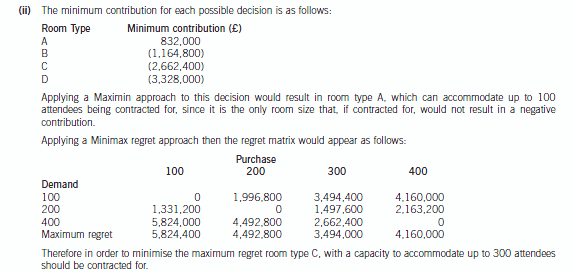
-
第15题:
(ii) Explain how the existing product range and the actions per Note (3) would feature in Ansoff’s
product-market matrix. (7 marks)
正确答案:
(ii) Market Penetration
With regard to existing products it would appear that a strategy of market penetration is being followed, whereby attempts
are made to sell existing products into existing markets. This is a low risk strategy which is most unlikely to lead to high
rates of growth, reflected in the forecast increase of 2% per annum in the years ending 30 November 2008 and 2009.
Management seeks here to increase its market share with the current product range. In pursuing a penetration strategy
the management of Vision plc may to some extent be able to exploit opportunities including the following:
– Encouraging existing customers to buy more of their brand
– Encouraging customers who are buying a competitor’s brand to switch to their brand
– Encouraging non-users within the segment to buy their brand
‘Strengths’ within the current portfolio will need to be consolidated and any areas of weakness addressed with remedial
action.
Market Development
The purchase of the retail outlets will enable management to sell existing products via new channels of distribution. The
products of both the Astronomy and Outdoor Pursuits divisions could be sold via the retail outlets. Very often new
markets can be established in geographical terms. Management could, for example, look to promote the sale of
microscopes and associated equipment to overseas hospitals.
Product Development
The launch of the Birdcam-V is an example of a product development strategy whereby new products are targeted at
existing markets. Very often, existing products can be improved, or if an organisation possesses adequate resources,
completely new products can be developed to meet existing market needs. Some of the main risks here lie in the ‘time
to market’ and product development costs which frequently go well beyond initial estimates.
Diversification
The purchase of Racquets Ltd is an example of diversification on the part of Vision plc since the products and markets
of Racquets Ltd bear no relationship to the existing products and markets of the company. In this regard the
diversification is said to be unrelated.
The establishment of the Oceanic division could be regarded as a related diversification since existing technology will be
used to develop new products for new markets. The success of this strategy will very much depend on the strength of
the Vision brand. -
第16题:
(b) Determine whether your decision in (a) would change if you were to use each of the Maximin and Minimax
regret decision criteria.
Your answer should be supported by relevant workings. (6 marks)
正确答案: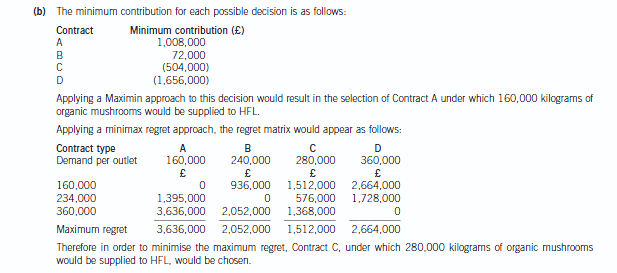
-
第17题:
(ii) State when the inheritance tax (IHT) calculated in (i) would be payable and by whom. (2 marks)
正确答案:
(ii) Inheritance tax administration
The tax on Debbie’s estate (personalty and realty) would be paid by the personal representatives, usually an executor.
Inheritance tax is due six months from the end of the month in which death occurred (31 December 2005) or the date
on which probate is obtained (if earlier). However, an instalment option is available for certain assets, which includes
land and buildings i.e. the residence whereby the tax can be paid in 10 equal annual instalments. -
第18题:
(ii) Compute the annual income tax saving from your recommendation in (i) above as compared with the
situation where Cindy retains both the property and the shares. Identify any other tax implications
arising from your recommendation. Your answer should consider all relevant taxes. (3 marks)
正确答案: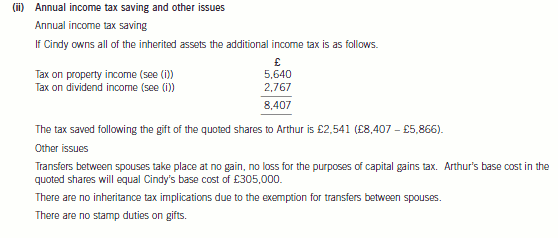
-
第19题:
(ii) State the taxation implications of both equity and loan finance from the point of view of a company.
(3 marks)
正确答案:
(ii) A company needs to be aware of the following issues:
Equity
(1) Costs incurred in issuing share capital are not allowed as a trading deduction.
(2) Distributions to investors are not allowed as a trading deduction.
(3) The cost of making distributions to shareholders are disallowable.
(4) Where profits are taxed at an effective rate of less than 19%, any profits used to make a distribution to noncorporate
shareholders will themselves be taxed at the full 19% rate.
Loan finance/debt
(1) The incidental costs of obtaining/raising loan finance are broadly deductible as a trading expense.
(2) Capital costs of raising loan finance (for example, loans issued at a discount) are not deductible for tax purposes.
(3) Interest incurred on a loan to finance a business is deductible from trading income. -
第20题:
(b) State the immediate tax implications of the proposed gift of the share portfolio to Avril and identify an
alternative strategy that would achieve Crusoe’s objectives whilst avoiding a possible tax liability in the
future. State any deadline(s) in connection with your proposed strategy. (5 marks)
正确答案:
(b) Gift of the share portfolio to Avril
Inheritance tax
The gift would be a potentially exempt transfer at market value. No inheritance tax would be due at the time of the gift.
Capital gains tax
The gift would be a disposal by Crusoe deemed to be made at market value for the purposes of capital gains tax. No gain
would arise as the deemed proceeds will equal Crusoe’s base cost of probate value.
Stamp duty
There is no stamp duty on a gift of shares for no consideration.
Strategy to avoid a possible tax liability in the future
Crusoe should enter into a deed of variation directing the administrators to transfer the shares to Avril rather than to him. This
will not be regarded as a gift by Crusoe. Instead, provided the deed states that it is intended to be effective for inheritance tax
purposes, it will be as if Noland had left the shares to Avril in a will.
This strategy is more tax efficient than Crusoe gifting the shares to Avril as such a gift would be a potentially exempt transfer
and inheritance tax may be due if Crusoe were to die within seven years.
The deed of variation must be entered into by 1 October 2009, i.e. within two years of the date of Noland’s death. -
第21题:
(ii) Briefly explain the implications of Parr & Co’s audit opinion for your audit opinion on the consolidated
financial statements of Cleeves Co for the year ended 30 September 2006. (3 marks)
正确答案:
(ii) Implications for audit opinion on consolidated financial statements of Cleeves
■ If the potential adjustments to non-current asset carrying amounts and loss are not material to the consolidated
financial statements there will be no implication. However, as Howard is material to Cleeves and the modification
appears to be ‘so material’ (giving rise to adverse opinion) this seems unlikely.
Tutorial note: The question clearly states that Howard is material to Cleeves, thus there is no call for speculation
on this.
■ As Howard is wholly-owned the management of Cleeves must be able to request that Howard’s financial statements
are adjusted to reflect the impairment of the assets. The auditor’s report on Cleeves will then be unmodified
(assuming that any impairment of the investment in Howard is properly accounted for in the separate financial
statements of Cleeves).
■ If the impairment losses are not recognised in Howard’s financial statements they can nevertheless be adjusted on
consolidation of Cleeves and its subsidiaries (by writing down assets to recoverable amounts). The audit opinion
on Cleeves should then be unmodified in this respect.
■ If there is no adjustment of Howard’s asset values (either in Howard’s financial statements or on consolidation) it
is most likely that the audit opinion on Cleeves’s consolidated financial statements would be ‘except for’. (It should
not be adverse as it is doubtful whether even the opinion on Howard’s financial statements should be adverse.)
Tutorial note: There is currently no requirement in ISA 600 to disclose that components have been audited by another
auditor unless the principal auditor is permitted to base their opinion solely upon the report of another auditor. -
第22题:
Using the #define statement, how would you
declare a manifest constant that returns the
number of seconds in a year? Disregard leap
years in your answer.
正确答案:
-
第23题:
问答题Task II (20 marks) Directions:Many nations’ serious school problems nowadays result from the students’ attitude. What causes these problems? What’s your opinion to deal with these problems? State your opinion in no less than about 160 words, and write it on the Answer Sheet.正确答案:
Nowadays in many nations there are serious school problems—absenteeism, disrespect for teachers, drug abuse, and tardiness. Serious school problems are positively associated with high-risk behaviors of teens: smoking, drinking alcohol, smoking marijuana, and so.
There might be many causes for these various school problems in different cases, but one reason is in common—the student’s attitude. Every single person is responsible for his or her own actions, so do the students. And if one’s attitude is upright, there would be no reason for him or her to misbehave. On the contrary, if a student is experiencing serious school problems, parents and teachers better take a close look into his or her attitude. There must be something wrong with it.
Thus, in order to prevent serious school problems, it is necessary to cultivate a positive attitude in the students. Positive attitude will bring out the best in them and will become the key to their success at school.
(Word Count: 158)解析: 暂无解析
